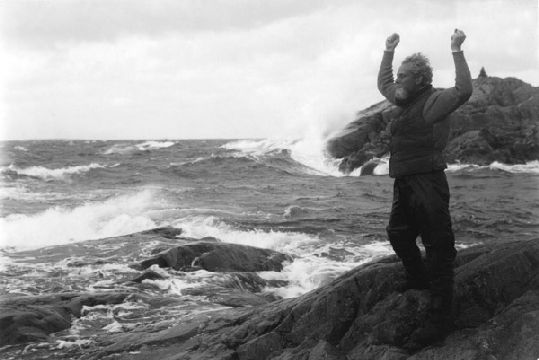Terje Vigen (1917) 

Director: Victor Sjöström
Cast: Victor Sjöström, Edith Erastoff, August Falck
Synopsis: Terje Vigen, a sailor, suffers the loss of his family through the cruelty of another man. Years later, when his enemy’s family finds itself dependent on Terje’s beneficence, Terje must decide whether to avenge himself.
Victor Sjöström was in the doldrums in 1916; he was despondent over both what he considered to be the inferior quality of his work to date, and the breakdown of his marriage to actress Lili Beck. Producer Charles Magnusson suggested to him that he make a screen version of Henrik Ibsen’s epic poem Terje Vigen. Initially doubtful, a trip to the Grimstad coast, the setting for Ibsen’s work, changed Sjöström’s mind. Although the limitations of his budget meant that he had to confine filming to the coastline around Stockholm, Sjöström nevertheless produced a film of stark, startling beauty, a tragedy with a paradoxically uplifting resolution in which man is pitted against nature, a theme to which he would return in his better known works, such as The Outlaw and His Wife and The Wind.
Terje Vigen (played by Sjöström after his original choice for the role dropped out) is a sailor who forsakes a life on the sea following the birth of his baby daughter, Anna. However, after a few years, the outbreak of war with Britain brings to an end the contented life he enjoys with his wife and daughter in a wooden cabin overlooking the sea. The island on which Terje and his family live is blockaded by the British fleet, leaving its inhabitants with a rapidly dwindling food supply. In desperation, Terje volunteers to attempt to run the blockade in his rowing boat and return with barley and grain from the mainland.
Although he succeeds in dodging the blockade on his way out, Terje runs afoul of them on his return. The captain of the British ship orders Terje’s boat to be sunk and orders that he be imprisoned for the duration of the war. Five long years pass before hostilities end and Terje can finally make his way home, but upon arriving there he finds strangers living in his cabin and learns that his wife and daughter died of starvation because of the blockade. Years later, fate offers him an unexpected opportunity to avenge their deaths…
Terje Vigen is a remarkably well-crafted film for 1917, and boasts some beautiful cinematography from Julius Jaenzon. Much of the film takes place outside, which not only helps to avoid the drawback of sparse and unconvincing set decoration, but also emphasises the conflict between man and nature that touched a number of Sjöström’s films. The craggy, rugged landscape has a bleak beauty that nevertheless makes clear the harsh life experienced by those who depend upon it, while the changeable moods of the surrounding sea possess their own dangerous beauty; impassive or turbulent but always unyielding, the sea emphasises the absolute entrapment of the islanders when the blockade begins.
As the eponymous character demands most of the screen time, selecting the right actor for the part was vital, and Sjöström is so convincing as Terje that it’s a wonder he didn’t cast himself from the off. Although his emotional moments might feel a little over the top by today’s standards, they’re actually quite restrained for a period in which many screen actors still laboured under the mistaken belief that they were still playing to the balconies. Sjöström also directs with a brisk authority that captures both the youthful vitality of Terje as he climbs a yardarm to unfurl a sail and his older melancholia at the loss of his wife and daughter. Having said that, although Terje appears to age about thirty years during the film, the British captain with whom he’s unexpectedly reunited in the final scenes doesn’t age at all leaving us to ponder over just how much time actually passes during the course of the picture. It’s true that his imprisonment has supposed to have aged Terje, but the difference in his appearance really is an unnecessary distraction.
The only other aspect of Terje Vigen that doesn’t work particularly well is, ironically, its use of lines from Ibsen’s poem as intertitles to describe much of the action. The decision to use them was presumably taken to lend authenticity to its re-enactment, but it’s sometimes difficult to make sense of the peculiar prose. Overall, though, that’s a minor quibble, and Terje Vigen stands as an unexpectedly sophisticated piece of work that appears to have lost none of its impact in almost one hundred years. The final shot, of a peaceful sea at sunset seen beyond the silhouette of the grave in which Terje’s wife and daughter lie, is particularly poignant.
(Reviewed 19th August 2014)
httpv://www.youtube.com/watch?v=PTsqTs4zcOE
